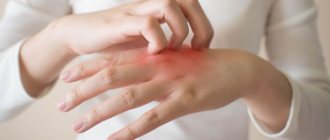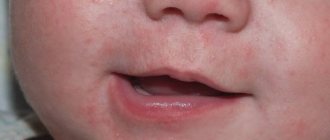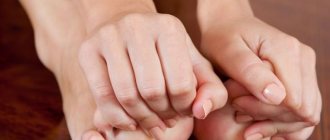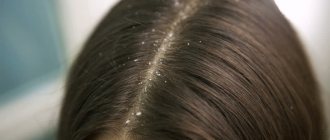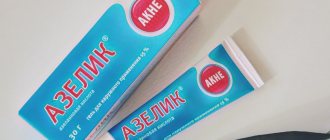Dermatoses most often appear on exposed areas of the skin as they are most susceptible to external factors.[1] This also applies to the skin of your hands. Symptoms such as itching, redness, peeling, various spots and other elements of the rash primarily affect the forearms, hands and fingers.
One of the mechanisms for the development of dermatitis on the fingers or hands is direct contact with a substance to which the body's immune system is not able to adequately respond. Skin allergy is a classic delayed hypersensitivity reaction in response to a single or systematic interaction with a pathogen.
Dermatological skin diseases are widespread, especially among working age adults.[2] For some patients, hand allergies can be a short-term problem: very often the symptoms go away on their own. Other patients struggle for a very long time with the disease and complications that can be caused by a secondary infection. In this case, hand allergies manifest themselves even more aggressively, the rashes become more widespread and unbearably itchy.
Types of hand allergies
Hand allergies mean a group of skin diseases, 20% of which are allergic dermatoses.[4] This type of skin pathology manifests itself at different ages, affects mainly older people, but can also begin in childhood as a sign of predisposition to dermatitis. Manifestations of allergies on the hands are typical for:
- atopic dermatitis (neurodermatitis);
- hives;
- contact dermatitis;
- eczema.
Each disease looks different. They also differ in duration of course, tendency to exacerbations and relapses. As a rule, the skin manifestations of atopic dermatitis and eczema persist for quite a long time, while urticaria and contact dermatitis are acute.[4] If you do not get rid of the external factors that triggered the allergy, the diseases will recur and eventually become chronic.
Eczema51
Eczema is a chronic allergic skin disease, which is characterized by the appearance of a polymorphic rash, acute inflammation, and itching.
The acute stage of the disease is characterized by the appearance of edema, erythema, against which vesicles, serous crusts, and punctate erosions with weeping are formed; papules and pustules with sterile contents are less often formed. If the pimples on the hands itch, this may indicate dyshidrotic and pruriginous eczema. So, with dyshidrotic eczema, the skin of the palms may become covered with itchy blisters and velculi. Pruriginous eczema is characterized by the appearance of small papulovesicles, mainly formed on the face and elbows, which can also cause itching.
Eczema develops due to neuroendocrine disorders, genetic predisposition, vegetative-vascular, metabolic, infectious and allergic factors.
Rashes on the hands: the most common diseases
In order to choose the right treatment, it is important to distinguish one type of allergic dermatosis from another. Therefore, let’s look at the symptoms of skin diseases in more detail:
- With atopic dermatitis (neurodermatitis), a rash often appears on the skin of the fingers and hands. The acute period of the disease is characterized by severe itching, redness and swelling of the skin. Itchy spots can come in different shapes and sizes. Without proper treatment, crusts may form at the site of the rash. In the chronic form, symptoms such as dry skin and flaking are observed.[3]
- Urticaria is divided into several types: immunological, physical, drug and idiopathic. The development of the first two is based on the body’s reaction to external stimuli, including food and household allergens, as well as high or low temperatures, sunlight and other factors. Taking certain medications can trigger drug-induced urticaria. Idiopathic is a rash whose cause cannot be determined.[4] All types of hives present more or less the same way: redness, swelling of the skin and the appearance of itchy blisters.
- Contact dermatitis often affects the skin on the fingers, especially when coming into contact with harmful substances such as rubber and metal products, household chemicals, cosmetics and perfumes, topical medications, certain plants and insects.[5] The disease can occur in both acute and chronic forms. The acute course is characterized by redness of the skin and the appearance of itchy blisters. The chronic form is accompanied by dryness and flaking of the skin, increased skin pattern.
- Eczema is an acute and chronic inflammatory disease that affects both the upper and lower extremities. It may also affect various parts of the body. As a rule, eczema rashes are symmetrical, accompanied by redness and limited swelling of the skin. Small blisters filled with clear liquid often appear on affected surfaces.[6]
Acne31
Acne is a chronic inflammatory disease of the sebaceous glands, which manifests itself in the formation of closed and open comedones, inflammatory elements - pustules, papules, nodules. Most often, acne appears in the so-called seborrheic zones, where the density of the sebaceous glands is approximately 400 - 900 per cm2. This is the face (forehead, chin, nose), scalp, back. Acne also appears in the décolleté area and upper arms.
There are several degrees of acne severity. There is no clear classification, but in Russian practice the division into mild, moderate, and severe degrees of acne is often used.
Clinically, acne manifests itself in the form of closed (black dots) and open (small white rash) comedones, papules (red inflamed pimples), pustules (papules with purulent contents). With severe acne, nodules and cysts may appear.
Causes of allergic reactions on hands
The main triggering factor for the development of allergic dermatoses is single or regular contact with the pathogen. In this case, treatment is aimed at completely eliminating the allergen to which the body is hypersensitive. It is quite difficult to determine, but among the most common causes of hypersensitivity are antigens from plants, animals, fungi, insects, foods, chemical compounds and drugs.
Also, allergic reactions on the fingers and other parts of the upper extremities occur due to:
- Gastrointestinal diseases. Diseases such as biliary dyskinesia, chronic gastritis and pancreatic dysfunction can trigger the development of allergic dermatitis and contribute to its transition to a chronic form.[3]
- Violation of the barrier function of the skin under the influence of mechanical, chemical and infectious agents. A broken epidermal barrier facilitates the penetration of allergens through the skin, the development of infection, and causes mild skin irritation.[7]
- Unfavorable environmental conditions. High levels of environmental pollution lead to an increased susceptibility of the population to allergic dermatoses.[8]
- Genetically determined factors. If both parents are prone to allergic diseases, the likelihood of developing neurodermatitis and other allergic dermatoses in the child is 70%.[9]
Scabies51
If small pimples on the arm are itchy, this may indicate that a person has scabies. This is a common parasitic skin disease that is caused by the scabies mite (Sarcoptes scabiei). Considering the daily rhythm of parasite activity, it can be explained why itching intensifies in the evening and at night. Among the methods of infection, direct contact with a sick person or infected objects predominates.
Localization of the disease: bends of the arms and legs, folds between the fingers, elbows, axillary cavities, wrist joints, abdomen, etc.
The clinical picture is often dominated by follicular papules (small pimples on the arms and torso), non-inflammatory vesicles near the passages, scratches and crusts.
Features of treatment
Treatment of skin diseases of an allergic nature requires an integrated approach. First of all, therapy should be aimed at the absolute exclusion of harmful pathogens, as well as at improving symptoms. Itching, swelling and redness cause patients severe discomfort, both physiological and emotional. Itchy spots make it difficult to sleep and work fully. In addition, the affected areas disrupt the aesthetics of the skin, so patients often hide them under clothing, which can only aggravate the situation. In addition, allergic reactions on the skin cannot be wetted, so patients are deprived of the opportunity to take a bath, visit the pool or sauna.
To eliminate a rash on the hands, it is necessary to use topical external agents in the form of ointments or creams. In the treatment of allergic dermatoses, drugs based on topical glucocorticosteroids have proven themselves to be effective.[10] Such products have wide application possibilities, since they have several effects on the inflammatory focus:
- anti-inflammatory effect;
- antiallergic effect;
- vasoconstrictor properties;
- antipruritic effect.
One of the representatives of local glucocorticosteroids prescribed for the treatment of allergic dermatoses are the drugs "Akriderm GK".
Azelik® is a drug for acne
Only a specialist can understand whether red pimples on the hands are a manifestation of acne or another disease. Therefore, in case of rashes, you should consult a dermatologist. One of the drugs that can be prescribed for mild to moderate acne is Azelik®.
The main component of Azelik® gel is azelaic acid. The foundation also includes an additional component - the emollient squalane, which helps moisturize and soften the skin. The drug has the following properties5:
- normalizes keratinization in follicles;
- has an antimicrobial effect, reducing the colonization of propionibacteria and Staphylococcus epidermidis;
- reduces the concentration of free fatty acids;
- has an anti-inflammatory effect by reducing the metabolism of neutrophils and the free forms of oxygen they produce.
Azelik® must be used twice a day5. Visible effect is usually observed after 4 weeks of use5.
Akriderm GK preparations for hand allergies
Depending on the form of the disease and the severity of the course, both ointment and Akriderm GK cream are used. They have a similar composition; the main difference is that the cream has a softer texture, so it is absorbed faster by the skin. It is more appropriate to use it for the treatment of acute and subacute conditions, as well as for weeping and thin areas of the skin. In turn, the ointment stays on the skin longer and has a high penetrating ability, therefore it is suitable for chronic inflammation accompanied by severe dryness and flaking.[10]
When Akriderm GK is applied to damaged skin, the preparations soften and cool the affected area, relieving itching and redness. The active substances not only improve symptoms, but also help eliminate pathogenic microorganisms. Thanks to the combined composition, which includes several active substances and auxiliary components, the treatment brings a noticeable and long-lasting effect.[11]
Diagnosis of sun allergy
If you notice an unusual reaction to the sun, I recommend contacting an allergist or dermatologist, who will prescribe you a certain range of analyzes and tests that can be used to confirm the presence of an allergy or a predisposition to it.
It is impossible to fight a disease without eliminating its causes, so be prepared to be offered a comprehensive examination:
- skin tests (scarification tests, prick tests, patch tests). Skin allergy tests are the fastest, safest and most reliable method of examination in immunology. Testing is carried out for patients from 5 to 50 years old;
- determination of the level of total immunoglobulin E;
- determination of the level of specific immunoglobulin E to household, epidermal, pollen, fungal, food, medicinal and bacterial allergens, as well as insect poison;
- determination of the level of specific immunoglobulins to food antigens - diagnosis of food intolerance;
- examination of sputum and secretions from the nasal cavity.
Causes
The causative agent of streptoderma, the photo of which you will find below, is group A streptococcus. However, it is worth noting that infection can only develop in a situation where certain factors are present:
- skin damage,
- lack of following basic hygiene rules,
- weak immune system,
- disruption of the endocrine system,
- dermatological diseases,
- depressive mood
- vitamin deficiency,
- constant washing of the skin, which leads to damage to the protective layer,
- strong influence of different temperature ranges,
- poisoning,
- circulatory disorders.
Preventive measures and prognosis
Due to the high risk of infection, sick children should keep their distance for some time and not contact other people. Quarantine is provided for up to 10 days. For the entire period of therapy, it is necessary to follow the rules of hygiene.
To prevent the development of the disease, it is necessary to disinfect the child’s personal belongings. Sick children should have a proper diet rich in nutrients. To improve the quality of the immune system, certain measures should be taken.
streptoderma treatment
As a rule, streptoderma ICD 10 in children is cured without any problems. Exacerbation of the disease and re-infection are observed mainly in children from disadvantaged families or in children with weak immunity. With timely treatment, symptoms disappear within one week. If you do not attach any importance to this, the disease can develop into a more severe form. In the worst case, the disease can lead to blood poisoning. For streptoderma, treatment with ointments and antibacterial agents is mandatory.
Therapy and drugs
Throughout the spread of the disease, basic hygiene rules should be observed: in the first days, it is forbidden to take baths and wet impetigo, and it is forbidden to comb the affected areas.
Therapy for this disease is aimed at destroying the pathogen and strengthening the protective functions of the immune system. As a complex treatment, antibacterial drugs of the category of cephalosporins, macrolides and penicillins are prescribed. If you have bullous streptoderma, you should stop taking medications. As an immunocorrective treatment, the drugs “Likopida”, “Amiksin” and their analogues are effective. Treatment with drugs for . Restoration of microflora in the intestines occurs with the help of probiotics and prebiotics. Appropriate antihistamines will help get rid of scabies.
Means that increase the body’s resistance to infections in the form of solutions - “Eleutherococcus”, “Echinacea”, “Leuzea”, etc.
Sets of vitamin nutrients should also be taken in accordance with the instructions.
Local treatment includes antiseptic drugs that prevent the spread of putrefactive bacteria. Such medications include various alcohols, brilliant green, as well as their analogues - “Fukartsin”, “Chlorhexidine”, “Miramistin”, “Rivanol” or the cauterizing agent “Resorcinol”.
The use of a huge number of zinc-based pastes, preparations and ointments for streptoderma in children with intense scabies.
Therapy
Streptoderma has occurred ? Even in cases where the initial examination was carried out by a pediatrician, only a dermatologist can select therapy. Doctors in this field have an understanding of drugs with a narrow scope of action.
The first step is to limit the child’s diet. The course of treatment also involves avoiding water procedures, which can cause the spread of the disease. Healthy areas of the skin should be washed with a solution of chamomile, and damaged areas should not be touched at all.
The sick person needs to choose the right wardrobe, from which items of clothing made from synthetics and wool must be removed.
Doctors advise popping blisters that form on the skin with a disinfected needle, after which the abscess should be drained twice a day. Healthy areas of the skin are washed with a boron solution.
If crusts appear on the skin, they should be treated with antibacterial gels or ointments.
In more complex situations, many other medications may be prescribed:
- antibiotics for streptoderma of the tetracycline or chloramphenicol series,
- means that prevent the occurrence of an allergic reaction,
- means aimed at improving the body's immune system,
- vitamin preparations,
- antipyretic.
The set of medications must be discussed with the doctor. With the right treatment, the symptoms disappear within a week, but after the severe form is eliminated, scars may remain. This is what streptoderma looks like .
what does streptoderma look like?
Causes of complications and re-infection
The reason for re-infection may be incorrect therapy when, for example, if you have primary criteria for improvement, you decide to stop therapy. The most important thing is to remember that you need to unquestioningly follow the advice and instructions of your doctor.
streptoderma complications

